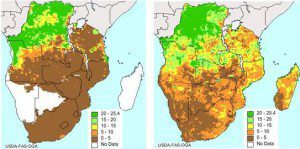
SMOS satellite data yields a better picture of soil moisture in southern Africa in mid-April 2014. The image on the left of soil moisture in southern Africa in April 2014 is based on rain gauge data only. The more detailed image on the right includes soil moisture data from ESA's SMOS mission that are assimilated into the U.S. Department of Agriculture's Foreign Agricultural Service forecasting system.
The European Space Agency's Soil Moisture and Ocean Salinity (SMOS) satellite delivers key scientific information on soil moisture and ocean salinity, plus its data are used for a growing number of practical applications.
The SMOS satellite has been in orbit around Earth for almost five years. Going way beyond its original scientific brief of delivering critical information to understand Earth's water cycle, it continues to demonstrate its suitability for new uses.
The most recent examples from this multitalented mission include being able to provide information to measure thin ice floating in the polar seas accurately enough for forecasting and ship routing. SMOS also is being used by the U.S. Department of Agriculture to predict drought and by the European Centre for Medium-Range Weather Forecasts to help improve air temperature and humidity forecasts.
Based on achievements such as these and the fact the satellite is still in good health, ESA's Member States and the French space agency CNES, which is responsible for operating the satellite platform, have decided to extend the mission's original planned life of five years.
Image courtesy of USDA Foreign Agricultural Service.

